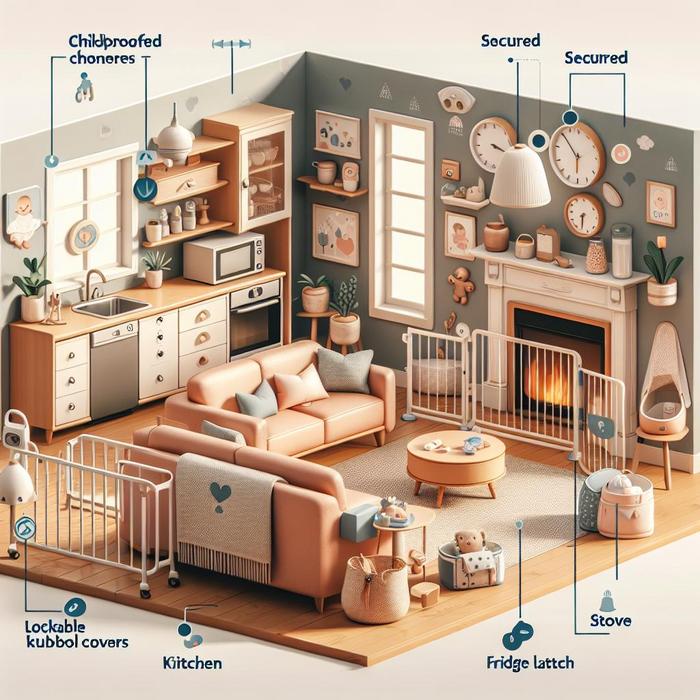Embracing Home Safety for Baby with Essential Upgrades
The Journey Towards a Baby-Proof Home
Expecting a baby brings extraordinary joy and anticipation. Along with that excitement comes the large responsibility of preparing your home for the new arrival. This preparation, often referred to as babyproofing, is crucial in ensuring the safety and comfort of your child. With a few straightforward steps, home safety for baby can be easily achieved, transforming your home into a secure haven for your bundle of joy.
Initial Steps in Baby-Proofing Your Home
Adapting your home for baby starts with a thorough assessment of your current living environment. As adults, we often overlook potential hazards since we are accustomed to navigating our homes safely. However, babies and toddlers, with their natural curiosity and propensity for exploration, see the home as one large playground. Hence, we need to adjust our perspective and identify potential risks from a baby’s point of view.
One of the most effective methods to initiate this process is by getting down at your baby’s level. Literally! Get down on your hands and knees and crawl around your home. This technique allows you to spot potential hazards from your child’s vantage point. Here, you should be on the lookout for sharp corners, accessible electrical outlets, cords, choking hazards, and unsecured furniture or appliances.
Essential Home Safety Upgrades for Your Baby
Once you’ve assessed potential hazards, it’s time to start making the necessary safety upgrades. To help with this process, let’s focus on some of the most essential babyproofing tips.
Kitchen:
- Install cabinet and drawer locks to prevent access to harmful substances or objects.
- Use stove knob covers to prevent your child from turning on the stove accidentally.
Bathroom:
- Ensure medicine cabinets are out of reach or locked.
- Install toilet locks to prevent drowning hazards.
Livings Areas & Bedrooms:
- Use furniture straps to secure heavy furniture, avoiding tipping hazards.
- Install window guards and stoppers to prevent falls from windows.
- Secure cords and blinds out of reach to avoid strangulation hazards.
These are just a few examples of the many safety upgrades you can undertake. However, remember to continually reassess your home as your child grows and begins exploring new areas.
Expert Help for Home Adaptation
If you feel overwhelmed by the task of babyproofing, don’t worry. There is plenty of expert help available. Various companies specialize in evaluating homes for potential dangers, then installing the necessary safety measures. These companies can provide you with the peace of mind you need to fully enjoy this exciting period of your life.
The Role of Care Providers in Baby’s Safety
Beyond home safety, it’s also important to practice safety habits when choosing your baby’s care providers. Whether you’re choosing a pediatrician or considering home care providers, safety should be a top priority. For more tips, you can check out our resources on selecting the right pediatrician and planning for infants and toddler care.
Laying the Foundation for a Safe Environment
Remember, preparation is key. As you embrace minimalist parenting, remember that doing more with less doesn’t mean compromising your baby’s safety. Begin adapting your home for your baby long before their arrival. This allows you plenty of time to handle unexpected issues or last-minute additions to your to-do list. Throughout this journey, remember to be patient with yourself. Home safety for your baby is a continual process that evolves as your child grows and explores.
Understanding the Importance of Baby-Proofing
The importance of baby-proofing your home cannot be overstated. According to a study appreciating the potential risks and taking preventive action can significantly reduce the occurrence of unintentional injuries in young children. Every small precaution is an opportunity to avoid a potential accident. By being mindful and proactive, you can create a safe and conducive environment for your baby to thrive.
Additional Safety Measures: Accommodating Special Needs and Pets
In families where there are special circumstances, such as a baby with Down syndrome or a family pet, additional considerations should be taken when baby-proofing your home.
For example, children with Down syndrome might have unique physical and cognitive needs that require further adaptations in your home. You might need to install additional safety guards, padding, or supports to cater to their needs. The Architectural Digest’s guide on Down syndrome accommodations can help you create a secure and filler life for children with Down syndrome.
Furthermore, if you have a pet, it’s important to prepare them for the new family member. The Humane Society offers invaluable advice on how to introduce your pets to your new baby in a way that ensures mutual safety and comfort.
Child Safety Products: Gadgets and Accessories
Over and above the recommended safety upgrades, there are numerous products in the market designed to enhance the safety of your child within your home. For instance, a spacesaving booster high chair can help your baby join you at the dinner table safely and comfortably. This not only encourages family bonding but also ensures that your baby is secure during meal times.
Baby-proofing is a process that often comes with its challenges, like dealing with unique home layouts, addressing hard-to-reach areas, or overlooking potential hazards. It’s important to bear in mind that there is no one-size-fits-all approach to baby-proofing. What works for one family might not be suitable for another. However, by consistently being mindful of your baby’s interactions with their surroundings, and by frequently reassessing your safety measures, you can robustly navigate these challenges.
Constructing a Culture of Safety
While baby-proofing becomes less critical as your child ages, advocating for safety at home should be a consistent practice. Emphasizing safety culture in your daily life will not only protect your child from immediate harm but also instill in them the importance of being mindful and proactive about personal safety from a young age. The lessons they learn during this phase could stay with them into adulthood and help them shape safer environments for themselves and for future generations.

